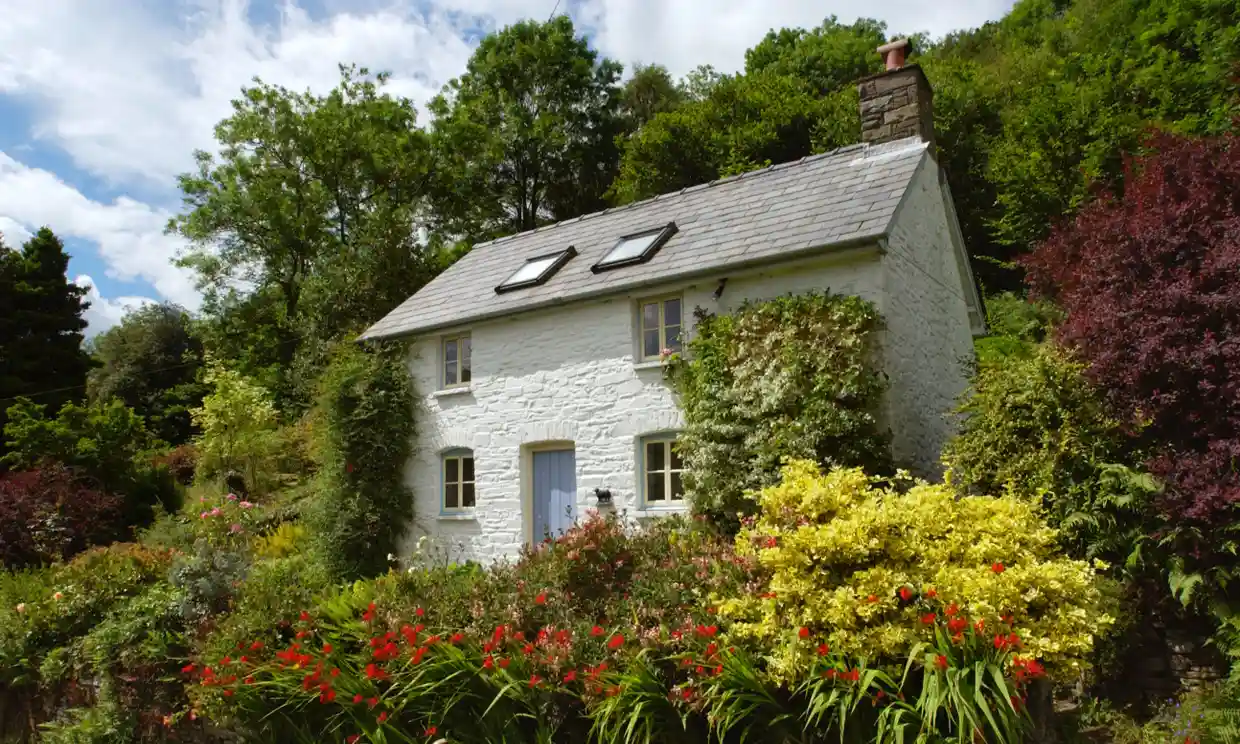
‘My boyhood’s haunt, through days of summer dreaming, / Under young leaves that shook with melodies!’ Photograph: Jeff Morgan/Alamy
A hymn to domestic and family content is shadowed by its painful loss
The Two Homes
Oh! If the soul immortal be,
Is not its love immortal too?
Seest thou my home? — ’Tis where yon woods are waving
In their dark richness, to the sunny air:
Where yon blue stream, a thousand flower-banks laving,
Leads down the hills a vein of light — ’tis there!
Midst these green haunts how many a spring lies gleaming,
Fringed with the violet, coloured with the skies,
My boyhood’s haunt, through days of summer dreaming,
Under young leaves that shook with melodies!
My home! — the spirit of its love is breathing
In every wind that plays upon my track,
From its white walls the very tendrils wreathing
Seem with soft links to draw the wanderer back.
There am I loved — there prayed for! — there my mother
Sits by the hearth with meekly thoughtful eye,
There my young sisters watch to greet their brother;
Soon their glad footsteps down the path will fly!
There, in sweet strains of kindred music blending,
All the home-voices meet at day’s decline;
One are those tones, as from one heart descending —
there laughs my home. Sad stranger! where is thine?
— Ask’st thou of mine? — in solemn peace ‘tis lying
Far o’er the deserts and the tombs away;
’Tis where I too am loved, with love undying,
And fond hearts wait my step — But where are they?
And where the earth’s departed have their dwelling,
Ask of the clouds, the stars, the trackless air! –
I know it not — yet trust the whisper, telling
My lonely heart, that love unchanged is there.
And what is home, and where, but with the loving?
Happy thou art, that so canst gaze on thine!
My spirit feels, but in its weary roving,
There with the dead, where’er they be, is mine.
Go to thy home, rejoicing son and brother!
Bear in fresh gladness to the household scene!
For me, too, watch the sister and the mother,
I will believe — but dark seas roll between.
This return-visit to the work of Felicia Dorothea Hemans (1793-1835) highlights a less familiar poem than the previous choice Casabianca. The Two Homes, first published in Songs of the Affections (1830) doesn’t initially declare its form as dialogue. It appears that Hemans, in typical Romantic style, is addressing her readers with her delight in the inextricability of home and nature. From the first verse I’d single out the images of the woods “waving / in their dark richness” and the stream as “a vein of light” as most distinctive. The second verse suggests multiple rivulets (“many a spring”), so the setting is easily imagined as a hill in Hemans’s “adopted” north Wales.
There’s fresh surprise in verse two, which reveals the speaker to be male. From “boyhood’s haunt” the description moves naturally to the home itself, the white-washed exterior whose tendrils “seem with soft links to draw the wanderer back”. These tendrils aren’t explained: shorn of specific detail, the word works on the reader’s imagination. I thought first of the vines in Keats’s ode To Autumn.
The domestic scene is captured well, if predictably, in verse four. The next adds a fresher dimension. The “home-voices” (an appealing coinage) are metaphorical music (and they might become actual music, if the sisters add singing to the evening’s entertainment). Family harmony, whether spoken or sung, lulls the speaker into further delight: “There laughs my home.” But this is the signal for a re-focus. Another presence is declared, in a deft act of poetic and conversational timing provoked by the word home: “Sad stranger! where is thine?”
Hemans brings this second speaker poignantly into view. The emphasis (“Ask’st thou of mine?”), echoing the earlier “thine”, makes us wait, fills the pause with questioning anticipation. That the stranger’s family is dead becomes swiftly apparent: the phrase “solemn peace” can imply nothing else. But the mystery lingers for the reader. Where are the physical remains located? Where is the stranger from?
The distance evoked (“o’er the deserts and the tombs away”) implies not only the distance between death and life. It suggests the stranger has travelled far. We’re not told the gender, but the poem’s underlying realism favours a male, perhaps a homeless ex-soldier or other recognisable migrant.
The remainder of the poem holds in balance the migrant’s sense that the lost loved ones are still intensely present, and that, at the same time, he’s disturbed because they cannot be located somewhere other than “the clouds, the stars, the trackless air”.
Resisting closure while returning to the A rhymes of verse four, but in reverse order (“mother/brother” becomes “brother/mother”) Hemans adheres stringently to her “plot”, the contrast between the two experiences. The stranger utters a generous blessing to his interlocutor. He asserts the determination to believe in his family’s watchful love. And then, immediately, death becomes intractable: “but dark seas roll between.”
Hemans builds The Two Homes from some fundamental imaginative resources. Her family moved from Liverpool to Gwrych, near Abergele, north Wales, in 1800, and she considered herself to be Welsh by adoption. After her marriage in 1812 she lived and raised five children in Wales, and remained there after her subsequent divorce, although she moved back to Liverpool after her mother’s death in 1827, and ended her days in Dublin. While she is attracted to themes of female attainment and self-sacrifice, family life, as here, has transcendent status in her poetry, and finding it is rarely straightforward.
The Two Homes begins with an epigraph from Song (“Fond dreams of love by love repaid”) by the abolitionist Norwich poet, Amelia Opie. Unfortunately I haven’t been able to track down the text of Song. Another interesting comparison is suggested by Richard Rutherford Johnston in Chapter 3 of his thesis, Romanticism and Mortal Consciousness, where he suggests that The Two Homes is a response to Wordsworth’s poem We Are Seven.






